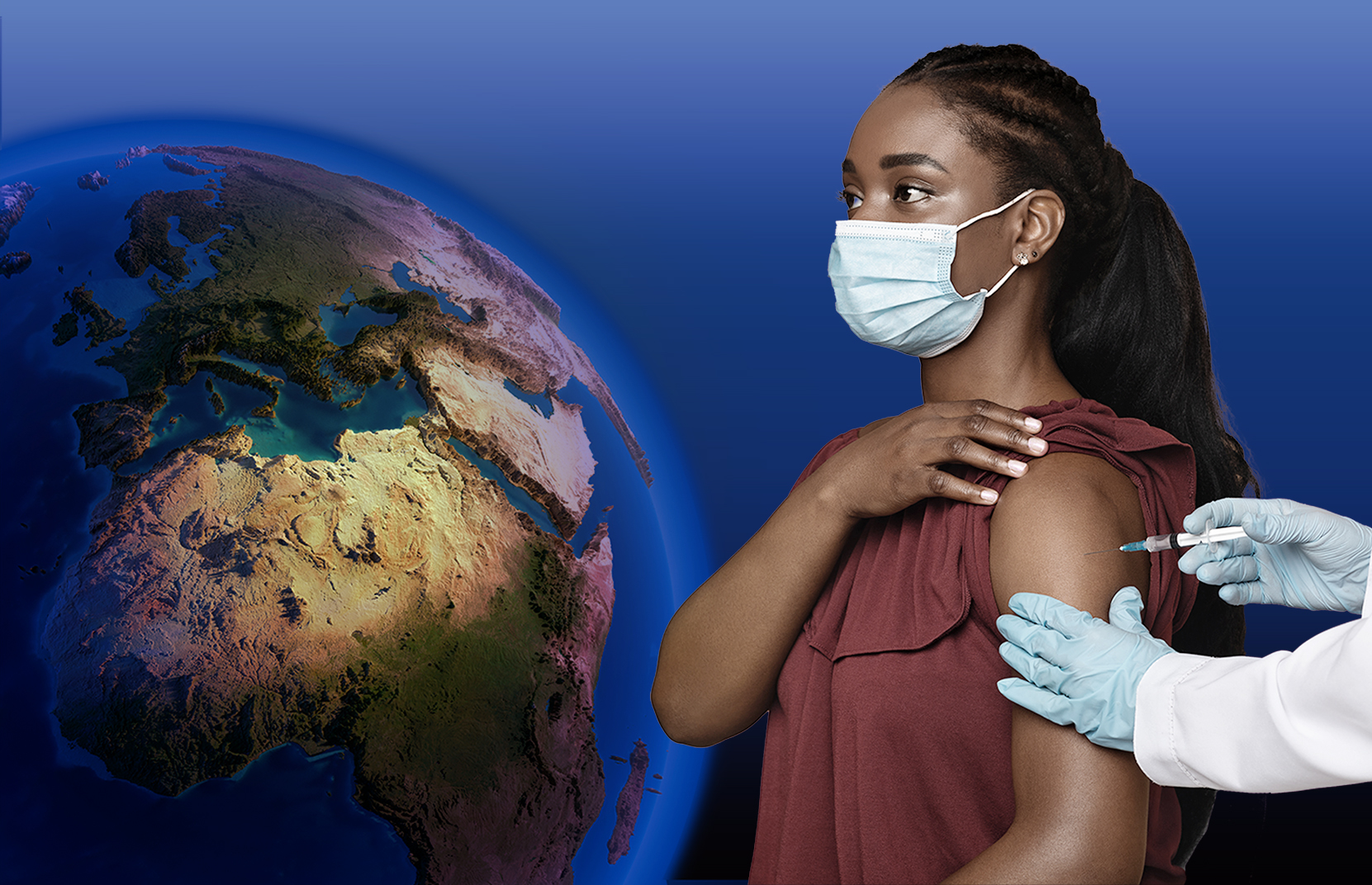Sub-Saharan Africa has mostly been ignored by developed countries focused on their own COVID-19 difficulties. But the region has fared remarkably well despite a vaccination rate that could prolong the crisis globally.
In late November 2021, the world discovered the perils of failing to more equitably distribute COVID-19 vaccines. The omicron variant emerged in Africa, a continent with some of the lowest vaccination rates, and swiftly went global. This was anticipated. Only a few months before, the Multilateral Leaders Task Force on COVID-19 Vaccines, a group led by multilateral institutions such as the World Bank, the International Monetary Fund (IMF), the World Trade Organization and the World Health Organization (WHO), explicitly warned about the risk of vaccination inequality and began to prepare a 2022 rollout of vaccinations to poorer countries.1
Many of those countries, with large unvaccinated populations, are in Africa. In this article, we will focus on sub-Saharan Africa, a diverse group of nations — 46 of Africa’s 54 — including Angola, Ethiopia, Kenya, Nigeria and South Africa. Each sub-Saharan country is unique historically, economically, financially, demographically and in terms of public health and resources. The pandemic hit many of these countries hard, but in some ways they fared better than many others in the developed world.
Almost two years after the emergence of COVID-19, the world is still struggling to recover. The pandemic has wreaked havoc on economies as well as individual livelihoods around the globe, from developed markets to emerging markets to frontier markets. However, contrary to early fears that the virus would disproportionately ravage the least-developed economies, the numbers of cases and fatalities reported in Africa have been relatively low compared with the rest of the world. This article is not just about the impact on those African nations but also about how this often overlooked region interacts with the rest of the world. That’s not to say Africa has escaped COVID-19 – With its low vaccination rate and fragile health care systems, the continent remains vulnerable to the virus. As a result, so is everyone else.
In fact, as Muhammad Ali Pate, a professor of public health at Harvard University, wrote in a recent essay for the Brookings Institution, Africa is a prominent example of both the prevailing weak global commitment to multilateralism — despite many promises, it is still short on vaccines — and the continent’s ability to pull itself together and act in a coordinated fashion to deal with the crisis. Perhaps, Pate writes, “the pandemic has created a reset moment for Africa’s health systems.”2
Pre-pandemic Progress
Over the past two decades, Africa has quietly made remarkable economic progress. Sub-Saharan Africa in particular boasted some of the world’s fastest-growing economies between 2007 and 2020, including Ethiopia, Ghana, Ivory Coast and Senegal.3 The region made significant progress toward achieving the United Nations’ Sustainable Development Goals, notably in improved maternal and child health, primary school enrollment, and youth literacy, as well as decreasing incidences of diseases such as malaria, tuberculosis and HIV. Some progress, albeit slow, has been recorded in eradicating poverty, with the number of people living in extreme poverty falling from 59 percent in 2000 to 41 percent in 2018.4
Then came the pandemic, which threatened to erode those gains.
In 2019, Africa’s population was estimated at 1.31 billion5 with an average annual growth rate of 2.3 percent,6 making it the second most populous continent after Asia. An estimated 1.2 billion,7 or about 91 percent, of Africa’s population lives in the sub-Saharan region. The continent has the youngest population in the world, with a median age of 20 years, compared with 31 for Latin America, 32 for Asia, 33 for Oceania, 37 for North America and 43 for Europe.8 The U.N. estimates that sub-Saharan Africa will account for 52 percent of the 2 billion people that will be born between 2019 and 2050.9
Africa is home to 30 percent of the world’s mineral reserves; sub-Saharan Africa holds 40 percent of global gold deposits and as much as 90 percent of global platinum and chromium deposits.10 Most sub-Saharan countries depend on commodity production or tourism, but the region’s economies are quite diverse, covering a spectrum from low to upper-middle income. A number of the countries are classified as fragile or conflict-affected,11 but steadily growing populations and rich natural resources present both an opportunity for growth and the political challenge of ensuring that resources are used to benefit the population.
The pandemic hit Europe, the Americas and Asia particularly hard. Early on, Africa appeared to escape the virus’s exponential surge of case numbers and high mortality rate. WHO’s initial analysis of the pandemic, in May 2020, suggested that Africa’s lower mortality rate might be attributed to its young population, as older adults were more likely to develop severe illness (at least before omicron).12 By 2021, Africa had reported 2 million cases, while the Americas had 36 million and Europe 38 million.13 The rapid and coordinated response of many African countries — lockdown measures, border closings and the promotion of hygienic practices such as hand washing — may have played a part in the low rate of infection. Also, some 58 percent of Africans live in rural areas, which may have reduced the spread.14 And the fact that Africa had wrestled with infectious epidemics, such as Ebola in West Africa in 2014–’16, may have helped. Ebola resurfaced in 2018 and was still prevalent in 2020 in the Democratic Republic of Congo, putting neighboring countries, such as Rwanda, on high alert when the first COVID-19 cases were reported on the continent.
Like most places, Africa had to deal with four surges of the virus. By the end of 2021, cases were mounting rapidly, driven by the delta and omicron variants, although hospitalizations and deaths were down.15 (This was particularly striking in South Africa, which first reported omicron and experienced a 66 percent increase in cases and a 67 percent rise in hospitalizations but saw the surge pass quickly.16) The big problem of getting the population vaccinated remained. Only 20 African countries reported 10 percent or higher vaccination rates; only six had more than 40 percent; only two — tourist centers Mauritius and the Seychelles — had over 70 percent.17
The Blow to Growth
When it comes to mass vaccinations, Africa suffers from a number of weaknesses. The continent lacks a robust homegrown pharmaceutical industry capable of developing vaccines or therapies. (South Africa, which was hard hit but reached out to buy vaccines and participate in trials, is an exception and, as a result, has a relatively high rate of vaccinations.) Public health infrastructure — everything from refrigeration to keep vaccines viable to rapid distribution to sequencing and testing — is lacking in many countries. Many places in Africa have hard-to-reach populations: Six countries told WHO that they had districts with no vaccination sites.18
Some of these problems are, at bottom, matters of underdevelopment. Many of the countries lack the resources to buy vaccines or build truly national distribution infrastructures. And developed nations have been slow to help out.
Economic growth in sub-Saharan Africa is largely driven by domestic demand and commodity prices. For some countries, recent discoveries of oil, gas and mineral resources have fueled growth. For example, Angola is the third-largest economy in sub-Saharan Africa and the second-largest oil producer in Africa. Oil and related activities account for about 50 percent of Angola’s gross domestic product and about 90 percent of its exports.19 Other factors have contributed to growth in sub-Saharan Africa, including the evolution of its services sector, particularly in communications, financial services, and housing and construction.20 All of these have resulted in a growing middle class.
The sub-Saharan region’s GDP grew by 3.2 percent in 2019 and was projected to grow by 3.6 percent in 2020.21 Growth was uneven, however. Diversified non-resource-rich countries were projected by the IMF to grow an average of 6 percent faster than resource-rich countries, thereby raising their per capita income higher than the world average.22 The sub-Saharan region’s growth rate, however, has not been strong enough to provide job opportunities to millions of young people entering the job market each year.23 The region suffered from chronic poverty, changing climate conditions and rising conflicts before the onset of the pandemic.
Measures such as lockdowns and border closings slowed global economic growth by 3.9 percent in 2020; the IMF described the contraction as being three times as severe as the 2008 financial crisis in half the time.24
The pandemic resulted in Africa experiencing its largest-ever recorded contraction — 1.9 percent — in 2020, eroding the gains of the previous two decades. The tourism-dependent Cape Verde, Mauritius and Seychelles saw employment, foreign exchange and government revenue come to an abrupt halt in the first half of that year; their economies shrank by as much as 16 percent. The IMF predicted that African tourist inflows would not return to 2019 levels until 2023.25 The second half of 2020, however, saw output recover more quickly than forecast as a result of a rebound in oil and base metal prices: The price of base metals grew by 36 percent between June and December 2020.
Global trade had slowed before the pandemic, with 2019 recording only 0.9 percent growth26 as a result of heightened trade tensions between the U.S. and China, and uncertainty over Brexit in the U.K.27 In sub-Saharan Africa, trade has historically taken place with the rest of the world rather than within the region. Over the past two decades, the region’s top trading partners have been the U.S., the U.K., France, Germany, India and South Africa, but it has more recently gained new partners, including China. The heavy tilt toward raw material exports, which account for about 40 percent of total exports,28 hampers the region’s growth prospects, with resources concentrated in labor-intensive and low-productivity areas rather than those with high external economies of scale, such as tradable industries like manufacturing, financial services, and IT consulting services.
In 2020, global trade declined by 8.5 percent,29 which the Organization for Economic Co-operation and Development described as the largest reduction in trade and output volumes since World War II.30 Lockdown measures introduced to stop or limit the movement and activities of people and goods hit value chains and slowed or halted trade in most countries. Most sub-Saharan countries experienced revenue losses, pointing to the need for resource-dependent economies to diversify their income sources and expand trade within the region.
Fiscal policy, especially in sub-Saharan Africa, was expansionary after the financial crisis, leading to deficits. After 2015, sub-Saharan Africa’s overall deficit began to decline, from 7 percent to 4 percent of GDP in 2019, and it was projected to further decrease in 2020.31 The falling fiscal deficit can be attributed to tax reform efforts and lower spending by countries such as Chad, Lesotho and Malawi between 2016 and 2018. Government revenues grew. Still, fiscal buffers in some of the countries remained inadequate. When the pandemic hit, falling commodity prices and lost tourism revenue on top of rising health and social expenditures widened the region’s deficit.
The eventual effect of deficits depends on financing, either through domestic or foreign borrowing or from central banks. How deficits are financed can lead to inflation, rising interest rates or depreciating exchange rates. Most countries in the region financed their deficits through borrowing, ending up with high debt ratios and, for some, inadequate repayment capacity. Average public debt in the sub-Saharan region increased from 40 percent to 59 percent of GDP between 2010 and 2018. Public debt as a percentage of GDP rose to 55 percent, with several countries, including Angola, Cameroon, Equatorial Guinea and Nigeria, doubling their debt-to-GDP ratios.32
Debt levels rose globally after the financial crisis, then again because of measures taken to contain the pandemic. Most economies financed deficits from both domestic and international markets, making the total deficit the highest in almost 20 years.33 Sixteen countries in the region were classified as in distress or at high risk of distress before the pandemic. Angola, Mozambique, Zambia and Zimbabwe suffered in part because of unsustainable debt owed to China.34 The debt profile across sub-Saharan Africa has been changing over the years, with private creditors such as sovereign bondholders and banks participating in long-term public debt at higher interest rates; China accounted for close to 27 percent of official debt servicing in 2020. Angola, for one, owes more than $20 billion to a number of Chinese entities, including China Development Bank, the Export-Import Bank of China and Industrial and Commercial Bank of China.35
Before 2000, inflows of foreign direct investment (FDI) into Africa lagged those for Asia and Latin America. However, there has been a marked increase in net inflows in recent decades. Sub-Saharan countries, especially resource-rich countries, benefited immensely from these inflows. The traditional recipients of FDI in the region were Angola, Nigeria and South Africa, but the flow is now more evenly distributed, with Kenya and Ethiopia also attracting investment money.36 Net inflows grew steadily, from $19.6 billion in 2005 to $44.3 billion in 2015, an increase of 126 percent. FDI flows declined steeply in 2016 and 2017 but recovered in 2018, growing by about 12 percent, from $27.6 billion in 2017 to $31.4 billion in 2019.37 The decline is mostly attributable to falling commodity prices in Nigeria and South Africa.38
As with FDI, non-resident portfolio investment flowing into sub-Saharan Africa has increased in the past decade. Most of the inflow has been in short-term instruments; this, coupled with the region’s greater integration into global financial markets, exposes it to fluctuations in global risk sentiment, commodity prices, currencies and interest rates. Sub-Saharan Eurobond issuance has increased dramatically over the past five years as countries have taken advantage of low global rates. Portfolio flows into the region remain concentrated in a few countries: Ghana, Nigeria and South Africa account for about 40 percent of total Eurobond issuance. Remittances are increasingly becoming an important source of capital inflows as a result of favorable global growth and the rising rate of migration.39
Global FDI dropped sharply as a result of the pandemic, from $1.54 trillion in 2019 to $1 trillion in 2020.40 The decrease was almost 20 percent below the decline in FDI recorded after the financial crisis. Similarly, FDI flows to sub-Saharan Africa dropped by 12 percent in 2020, although the impact varied across the region. For example, FDI inflows to Nigeria increased to $2.4 billion in 2020 from $2.3 billion in 2019, and inflows to Ghana fell from $3.9 billion in 2019 to $1.9 billion in 2020.41 Yet the outlook for the sub-Saharan region remains relatively positive – the U.N. Conference on Trade and Development’s latest World Investment Report predicts that FDI flows will rise in 2021 and may reach pre-pandemic levels in 2022, especially with the implementation of the African Continental Free Trade Area and its Sustainable Investment Protocol. The same trends were recorded for foreign portfolio investment (FPI) flows. Portfolio outflows after the pandemic hit were largely the result of policy uncertainties exacerbated by the fall in commodity prices. Remittances also fell as global growth contracted. But, there are expectations for a bounceback as economies globally recover.42
Policies of Resilience
The shock of the pandemic left governments in both developed and developing nations contending with a combined health and economic crisis on a scale no one had anticipated. Policymakers now face the need to create targeted, coordinated and sustained policies to ensure economic recovery and resilience to future shocks. Leaders in sub-Saharan Africa can promote greater resilience in their economies by implementing policies that strengthen macroeconomic stability, advance digitalization and enhance political, social and environmental governance.
Policies to promote digitalization can play a vital role in the recovery process. Digitalization offered new tools to respond to the pandemic and aided the deployment of social programs and essential government services. The use of interactive WhatsApp and Facebook platforms in Niger and South Africa provided automated responses to pandemic-related questions in local languages. Drones were used in Ghana to transport COVID-19 samples from rural communities to testing sites. Electronic tax filing is helping governments improve revenue collection and expand their tax bases. South Africa’s digitalized tax services reduced the processing time of most personal tax assessments to three seconds, compared with 180 days in 2006.43
The region could also use the crisis of the pandemic to address climate change risks to financial sustainability and resilience. One way this can be done is through debt-for-climate swap arrangements with creditors that provide bilateral or multilateral debt relief, which would allow vulnerable developing countries to reduce external debt while investing funds in national climate adaptation and mitigation programs. It would also be an innovative way of tackling challenges relating to insufficient climate finance as well as debt sustainability.
Policymakers in the sub-Saharan region need to ensure that their health sectors receive adequate support to combat the coronavirus and other preventable diseases. Africa imports an estimated 90 percent of its pharmaceutical products from the rest of the world,44 resulting in shortages of drugs after supply chains were disrupted in 2020. Policies to reduce dependence on foreign pharmaceuticals and promote production in the region would better position Africa to cope with future outbreaks.
Although uncertainties remain, the world is bringing the pandemic under control through vaccination. The speed of global economic recovery partly depends on the path the virus takes, which in turn depends on the effectiveness of vaccine coverage, especially in the least-developed countries. Vaccine coverage is a global public good, particularly with the possibility of new variants emerging among unvaccinated populations. The longer the pandemic lingers, the more resources will be required to contain its impact. A vaccine rollout that overlooks developing countries inflicts costs on both developed and less developed economies. As we have learned, a crisis prolonged by a lack of access to COVID-19 vaccines hurts not only countries within sub-Saharan Africa but the rest of the world as well.
Hauwa Danmadami is Deputy Manager of the Economic Research and Policy Management Division at the Securities and Exchange Commission in Nigeria and worked as an Intern at WorldQuant as part of the IFC–Milken Institute Capital Markets Program. She holds a Master of Finance and Business Economics degree from the University of Adelaide in Australia.
Esi Monney is a Manager in the Funds Management Division at the Securities and Exchange Commission in Ghana and worked as an Intern at WorldQuant as part of the IFC–Milken Institute Capital Markets Program. She holds a Master of Science in Investments from the University of Birmingham in the U.K.




